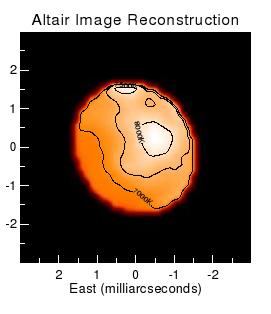The Flying Star
 Wed 2007-06-13
Wed 2007-06-13 
Back in the 1980's, when I used to observe variable stars, I would often go out on clear summer evenings and wait for the sky to get dark. I had a routine. First I would take the tripod of my Celestron 8 out onto the back lawn, unfold its aluminium legs and clip then together. Then I would go back indoors and bring out the wedge and bolt that to the top of the tripod. Finally I would carefully carry out the telescope itself and bolt that on top of the wedge. Then I would sit on the wooden garden seat and focus the telescope on a convenient bright star. On summer evenings that convenient star was usually Altair the first magnitude star in Aquila, the constellation of the Eagle. Focussing on this sharp bluish white point of light confirmed to me that the telescope was still working. (It always did work, but I found it comforting to get this confirmation, and it set my mind into the right mood for the hours of silent, solitary work ahead.)
The above (false colour) image of Altair is from a recent paper (J. D. Monnier et al, Imaging the Surface of Altair, 2007, arXiv 0706.0867 [astro-ph]) and was constructed from infrared observations made with the University of Georgia's CHARA interferometric array. Altair has long been known, from optical spectroscopic observations, to be a rapidly rotating star. The current theory of how rotation should affect the structure of a star was worked out as far back as 1924 by von Zeipel. This theory predicts the amount of flattening at the poles and the degree to which the equator will be cooler than the poles. In the above image the pole is in the bright spot just above and to the right of centre. Recently interferometric observations, including those by Monnier et al, have started to reveal discrepancies between the theory and reality. The largest discrepancy found so far is for the southern start Achernar which appears to be significantly flatter than predicted (ie: the poles are brighter and the equator darker than it should be). However, any modification to von Zeipel's theory to bring it into line with the observations is likely to have implications for the evolution of these stars.
I just find it interesting to see some detail on my 'sharp bluish-white point'. Another decade of technological advances and we should be able to see some really interesting detail on nearby stars. I suspect that explaining these details will lead to further refinement of our theories of stellar evolution.

Reader Comments